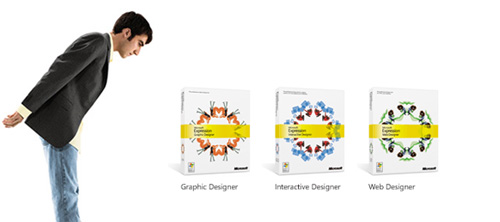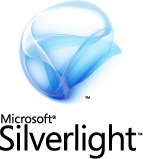 A lot of eyebrows were raised in the web design and development community when Microsoft announced that they were diving head first into the web development market with a new program package designed to be in direct competition with Adobe’s (formerly Macromedia) Flash platform. In conjunction (though somewhat delayed) with the release of Windows Vista comes the release of Microsoft Expression – a series of programs designed and developed for designers and developers. To introduce the new product, they put on a shindig at the swanky Canvas Lounge in Gastown, Vancouver and invited the tech and design elite of the city for appies, free drinks and a small business card case with the codes for everyone to try out the new vehicle.
A lot of eyebrows were raised in the web design and development community when Microsoft announced that they were diving head first into the web development market with a new program package designed to be in direct competition with Adobe’s (formerly Macromedia) Flash platform. In conjunction (though somewhat delayed) with the release of Windows Vista comes the release of Microsoft Expression – a series of programs designed and developed for designers and developers. To introduce the new product, they put on a shindig at the swanky Canvas Lounge in Gastown, Vancouver and invited the tech and design elite of the city for appies, free drinks and a small business card case with the codes for everyone to try out the new vehicle.
The evening started with a presentation by GK VanPatter of NextD on the future of design. VanPatter opened by telling everyone that he was giving a 15 minute version of a 2-hour lecture and then proceeded to crash through a PowerPoint presentation which for me was interesting for its philosophical and anthropological aspects but for the setting was sort of a misfit. I wouldn’t mind seeing the full presentation myself but I doubt the majority of the attendees were interested. After all, they were there to check out the new shiny stuff from Microsoft – not hear about how the brave new world of design requires new types of collaborative synergies and multi-disciplinary cohesion. That said, I advise anyone interested in design to check out NextD’s web site – it is a trip through a rabbit hole seldom explored and in sore need of attention. I’ll get back to that soon.
Second on the docket was Danny Riddell of Metaliq, introduced as a demonstrator of the use of Microsoft Expression software. However, the presentation became a bizarre example of the very concepts VanPatter had just talked about. Riddell was excellent but for one thing: It was not clear until far into the presentation that he was not actually demoing the software but applications built using the software. And the applications – an online live video editor called Top Banana and a GPS snowboarding tool – flashy and impressive as they were, lacked one important element: an actual use. VanPatter had been talking about the disconnect between designer, developer, client and end user. Top Banana was maybe the perfect example: An impressive application with no clear purpose. As a demo element it was excellent but the question of what the thought behind it was left a sense of confusion rather than awe. And then the application crashed.
Finally they got down to brass tax: The Expression Studio itself. Rini Gahir of Microsoft led the crowd through the major elements and their benefits both to designers and developers. The package has four elements:
- Expression Web – A code/WYSIWYG web editor to create standards-based sites. Think Adobe Dreamweaver.
- Expression Blend – An animation and layout tool to create elements, layouts and animations. Think Adobe Flash.
- Expression Design – An illustration and graphic design tool to create vector based graphics for web and desktop applications. Think a cross between Adobe Illustrator and Freehand.
- Expression Media – An asset management tool to catalogue and organize pictures, graphics, video and audio. This tool also contains the Expression Media Encoder which lets you batch process and convert images, audio and video. Think Adobe Bridge and Lightbox.
What is compelling about Microsoft Expression is the ability for the different levels of the design/development process to coexist. This is done by creating an environment where purely graphic layouts and animations automatically generate script that can be altered directly. This has often caused problems in Flash because there is an inherent disconnect between the graphical elements and the technical ActionScript. Another advantage is the impressive video streaming abilities the Silverlight plugin enables. To top it off the programs operate with vector based graphics and non-destructive effects to simplify the design process.
 Considering the history of digital design and the rivalry between Mac and Microsoft, it’s not too far a stretch to say they were preaching to a pack of wolves. It didn’t take long for questions of cross-platform compatibility and new web standards to take centre stage. After all; the web animation market is dominated by Flash and there are already several major players in the web video field including Adobe (Flash Video), Microsoft (Windows Media), Apple (QuickTime) and Real (Real Player). Microsoft Expression would be introducing a new system – Silverlight – into an already saturated market. Is there really room for another browser plug-in? The answer from Microsoft was not surprisingly “yes.” Although Silverlight is not included in Windows Vista, “it will be in the next release,” Rini Gahir assured me. And don’t be surprised if it turns up in the next “critical update” if you’re already running the new OS. For those running XP, Mac or Linux boxes, the 2mb plug-ins are already available. And seeing as we are talking about Microsoft and not some unknown entity, one can expect that Silverlight will be found on almost all computers within the next few years.
Considering the history of digital design and the rivalry between Mac and Microsoft, it’s not too far a stretch to say they were preaching to a pack of wolves. It didn’t take long for questions of cross-platform compatibility and new web standards to take centre stage. After all; the web animation market is dominated by Flash and there are already several major players in the web video field including Adobe (Flash Video), Microsoft (Windows Media), Apple (QuickTime) and Real (Real Player). Microsoft Expression would be introducing a new system – Silverlight – into an already saturated market. Is there really room for another browser plug-in? The answer from Microsoft was not surprisingly “yes.” Although Silverlight is not included in Windows Vista, “it will be in the next release,” Rini Gahir assured me. And don’t be surprised if it turns up in the next “critical update” if you’re already running the new OS. For those running XP, Mac or Linux boxes, the 2mb plug-ins are already available. And seeing as we are talking about Microsoft and not some unknown entity, one can expect that Silverlight will be found on almost all computers within the next few years.
Microsoft Expression is a compelling offering in a world that has been dominated by one company. The real question is if and when we should be making the transition. No doubt Flash will prevail in the market for the foreseeable future but unless you have a crystal ball or a time machine, there is no saying what will happen down the road. Should you go with Microsoft Expression or Adobe Flash? Or maybe even a combination of both? It’s a tough call and there are no clear answers. All we know is that there’s a new player on the field and that opens up new possibilities.
For another perspective check out Boris Mann’s blog
Note: AndNowYouKnow’s mother company Pink & Yellow Media has been using Macromedia (now Adobe) software for many years. To properly test out the new programs from Microsoft, we are switching to Expression Studio for a month to see if it lives up to its lofty promises. Stay tuned for updates on the progress and find out whether or not this is something you should invest in.
5 responses to “Microsoft Tries its Hand at Design…and Hiding the Elephant”
Hopefully it lives up to your expectations Morten! 🙂
Good recap of the evening. But what do you mean with this bit:
I thought I explained everything in great detail?! Nah, just kidding. 🙂
When comparing the offerings from Adobe and Microsoft, would you say there’s a good match in the Expression suite for Adobe’s prototyping program Fireworks? I saw a little demo of Fireworks Wednesday, and it looks like it could be an excellent tool for a graphically challenged software design guy like me. The closest match that I can see is the Blend program, but it looks a little too big and rich for my taste.
Cheers,
Jan Karlsbjerg
http://www.jankarlsbjerg.com/blog/
To Jan:
If I were to find a comparative element to Fireworks in the Expression Suite it would as you say have to be Blend. I have yet to try the suite tho so that would be a theoretical statement only. Stay tuned for my comments on real-life use and testing.
[…] Microsoft: The Microsoft Expression Suite (you can read about the event in our our technology blog AndNowYouKnow.net). Seeing as much of Pink & Yellow Media’s business comes from web design this suite is […]
[…] http://andnowyouknow.net/mac/microsoft-tries-it%e2%80%99s-hand-at-design-and-hiding-the-elephant-200… […]